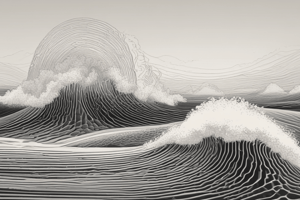Podcast
Questions and Answers
What results from constructive interference when two waves are in phase?
What results from constructive interference when two waves are in phase?
- A wave of greater amplitude (correct)
- A wave of reduced amplitude
- No change in wave amplitude
- A cancellation of the waves
What is the formula for destructive interference when two waves are out of phase?
What is the formula for destructive interference when two waves are out of phase?
- A_{resultant} = A_1 imes A_2
- A_{resultant} = A_1 - A_2 (correct)
- A_{resultant} = A_1 + A_2
- A_{resultant} = |A_1 - A_2|
What condition is required for two waves to create an interference pattern?
What condition is required for two waves to create an interference pattern?
- They must maintain a constant phase relationship (correct)
- They must be incoherent
- They must be of unequal amplitude
- They must have different frequencies
In the context of wave interference, what does a path difference of $n
rac{ ext{λ}}{2}$ indicate?
In the context of wave interference, what does a path difference of $n rac{ ext{λ}}{2}$ indicate?
Which experiment is known for demonstrating light wave interference and particle-wave duality?
Which experiment is known for demonstrating light wave interference and particle-wave duality?
Which of the following factors does NOT affect wave interference?
Which of the following factors does NOT affect wave interference?
What is the resultant displacement using the superposition principle?
What is the resultant displacement using the superposition principle?
In thin-film interference, which phenomenon leads to colorful visual effects in soap bubbles?
In thin-film interference, which phenomenon leads to colorful visual effects in soap bubbles?
Flashcards are hidden until you start studying
Study Notes
Interference
-
Definition: Interference refers to the phenomenon that occurs when two or more waves overlap and combine to form a new wave pattern.
-
Types of Interference:
- Constructive Interference:
- Occurs when waves are in phase (crests align with crests, troughs with troughs).
- Results in a wave of greater amplitude.
- Formula: ( A_{resultant} = A_1 + A_2 )
- Destructive Interference:
- Occurs when waves are out of phase (crests align with troughs).
- Results in a wave of reduced or zero amplitude.
- Formula: ( A_{resultant} = A_1 - A_2 )
- Constructive Interference:
-
Conditions for Interference:
- Waves must be coherent (maintain a constant phase relationship).
- Identical frequency and a consistent phase difference.
-
Interference Patterns:
- Fringe Pattern: Alternating light and dark bands observed in experiments, such as the double-slit experiment.
- Path Difference: The difference in distance traveled by two waves arriving at a point. Influences the type of interference:
- Constructive: Path difference = ( n\lambda ) (where ( n ) is an integer, ( \lambda ) is wavelength)
- Destructive: Path difference = ( (n + 0.5)\lambda )
-
Applications:
- Used in thin-film interference (soap bubbles, oil slicks).
- Important in optical devices (lens design, microscopy).
-
Mathematical Representation:
- Generally modeled using the wave equation:
- ( y(x, t) = A \sin(kx - \omega t + \phi) )
- Superposition principle: The resultant displacement at a point is the sum of displacements due to individual waves.
- Generally modeled using the wave equation:
-
Real-World Examples:
- Sound waves causing beats (constructive and destructive interference).
- Radio signals interacting (signal amplification and cancellation).
-
Key Experiments:
- Double-Slit Experiment: Demonstrates light wave interference and particle-wave duality.
- Young's Experiment: Classic experiment showcasing the interference of light.
-
Factors Affecting Interference:
- Wavelength of the waves.
- Medium through which the waves travel.
- Source distances and angles from the observation point.
Interference
- Definition: The combination of two or more waves, resulting in a new wave pattern.
- Types:
Constructive Interference
- Occurs when waves are in phase.
- Increases the amplitude of the resulting wave.
- Formula: ( A_{resultant} = A_1 + A_2 )
Destructive Interference
- Occurs when waves are out of phase.
- Decreases the amplitude of the resulting wave.
- Formula: ( A_{resultant} = A_1 - A_2 )
- Conditions:
- Coherent waves: Maintain a constant phase relationship.
- Identical frequency: Waves oscillate at the same rate.
- Consistent phase difference: The difference in starting points of the wave cycles remains constant.
- Patterns:
Fringe Pattern
- Alternating bright and dark bands observed during interference.
Path Difference
- The difference in the distance traveled by two waves.
- Influences the type of interference:
- Constructive: Path difference = ( n\lambda ) (n is an integer, ( \lambda ) is wavelength)
- Destructive: Path difference = ( (n + 0.5)\lambda )
- Applications:
- Thin-film interference: Creates colorful patterns in soap bubbles and oil slicks.
- Optical devices: Lens design and microscopy.
- Mathematical representation:
- Modeled using the wave equation: ( y(x, t) = A \sin(kx - \omega t + \phi) )
- Superposition principle: The combined displacement at a point is the sum of individual wave displacements.
- Examples:
- Sound waves: Create beats (alternating loud and quiet sounds).
- Radio signals: Can cause amplification and cancellation.
- Key experiments:
- Double-slit experiment: Demonstrates wave nature of light, shows interference patterns.
- Young's experiment: Classic demonstration of light interference.
- Factors affecting interference:
- Wavelength of the waves: Determines the spacing of the pattern.
- Medium: Affects the speed of the waves, influencing interference patterns.
- Source distances and angles: Influence the path difference and thus the type of interference.
Studying That Suits You
Use AI to generate personalized quizzes and flashcards to suit your learning preferences.




